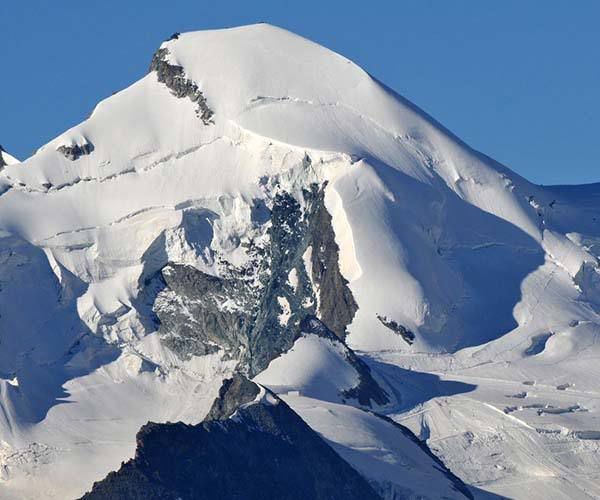
As things stand at the moment the travel industry has pretty much ground to a halt. Trying times, indeed. However the only constant thing is change and there will come a day when things return to normal, whatever normal is! In the meantime I guess we can all dream of that day when we can slate our thirst for wanderlust once again. Here’s something you might like to consider when that day arrives. Zermatt is almost completely surrounded by the high mountains of the Pennine Alps and it may surprise you to read that there are in total 38 peaks all of which are over 4,000m in the region.
This includes the Matterhorn, Monte Rosa and its tallest peak, the Dufourspitze, which happens to be Switzerland’s highest peak at 4,634 metres. A true paradise for alpinists and anyone who feels at home in a mountain landscape. If you fancy a climb, pack your crampons and your ice picks and make your way to Zermatt. If the very thought of clinging to vertiginous heights gives you the shivers just bring your camera and snap away at arguably the most spectacular and magnificent scenery in the whole of the Alps, blogs Dan Frith.
Allalinhorn (4,027m)
The Allalinhorn is one of the easiest 4,000-metre peaks in the Alps to climb, and also one of the most popular. From the summit, climbers see almost the entire sweep of the Western Alps. The first ascent was in 1856. In 1828, Heinrich Michaelis and a guide crossed the Allalin Pass and thereby opened up the route to the south-west ridge. The first ascent of the Allalinhorn via the same ridge took place 28 years later. On 28 August 1856, the parish priest Johann Josef Imseng and his manservant Franz Josef Andenmatten led the Englishman Edward Levi Ames to the summit.
Today’s normal route, the north-west ridge, was first used on 1 August 1860. The Bernese high school teacher and historian Heinrich Dübi ascended the summit via the difficult north-east ridge on 27 July 1882 with the guides Alphons and Peter Supersaxo, and then descended via the Hohlaubgrat ridge. This represented the first crossing of both ridges.
The first winter ascent of the Allalin was by the Swiss mountaineer R. Bracken, climbing solo, in 1907. The first ascent on skis was on 17 April of the same year by A. Hurter und Max Stahel, both from Zürich, together with the local mountaineers Othmar and Oskar Supersaxo.
The Metro Alpin carries mountaineers from Saas-Fee up towards the peaks, to an altitude of nearly 3,500 m. The summit of the mountain is a climb of about two hours from the top station of the funicular. The summit is located on the Mischabel ridge between the Saas and Matter valleys. The Allalinhorn is a white dome between the mountaineering centres of Saas-Fee and Zermatt. A mountain guide is necessary and acclimatisation is recommended. It’s a glacier trek with a little rock and scree but is considered an easy climb.
The mountain guide Camillo Supersaxo from Saas Fee has climbed the Allalinhorn more than 1,000 times. To celebrate the anniversary, Bishop Eldingen said mass on the summit.
The Breithorn (4,164m)
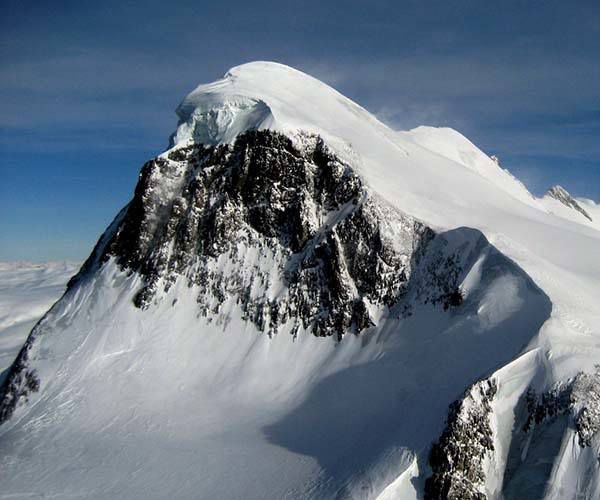
Breithorn is a heavily glaciated mountain crest with several peaks. Many budding mountaineers choose this for their first 4,000-metre summit. The first ascent was in 1813 by, Henry Maynard, Joseph-Marie Couttet, Jean-Baptiste Erin, Jean-Jacques Erin, Jean Gras. Considered the easiest 4,000-metre peak in the Alps. Breithorn is accessible in roughly 2 hours from the Matterhorn Glacier Paradise cable car station. A mountain guide is necessary and this is a pure glacier trek.
In July 1995, the Zermatt mountain guide Ulrich Inderbinen climbed the Breithorn and the Allalin more than a dozen times. He was 95 years old at the time. After a harmless fall on the return from the Breithorn, Inderbinen ended his 70-year career as a mountain guide in the summer of 1995.
“Breit” means “broad”: a fitting description for this mountain crest with multiple peaks, which extends for more than two kilometres. The western summit is the highest, but is also considered the easiest to climb. The middle and east summit and the Breithorn Twins form a chain towards the east. The most easterly summit, which marks the end of the Breithorn, is the Schwarzfluh (Roccia Nera). The border between Valais and the Autonomous Region of the Aosta Valley runs over the Breithorn. The peak also forms part of the main ridge of the Alps, which is both the regional watershed and meteorological divide.
Dufourspitze (4,634m)
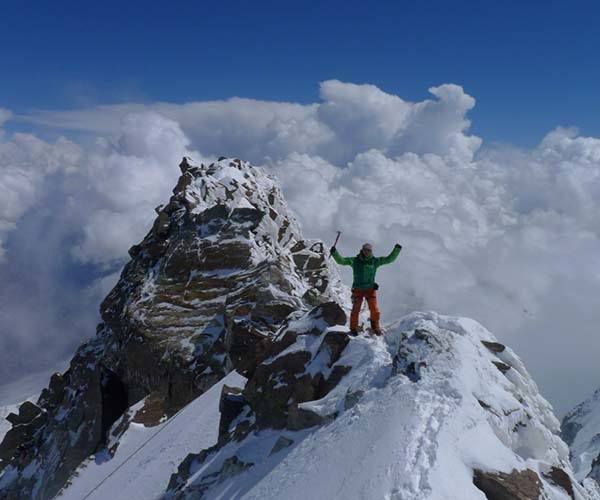
The first ascent took place on 1 August 1855 by a rope team led by Charles Hudson. Hudson was subsequently a member of the team that completed the first ascent of the Matterhorn, in 1865 and sadly, one of the four climbers who fell to their deaths during the descent. On the Dufourspitze, Hudson was accompanied by John Birkbeck, Edward J.W. Stephenson and the brothers Christopher and James G. Smyth.
The Dufour peak is the highest summit in Switzerland and one of the ten main summits of the Monte Rosa massif. Its rival is the Dom, the highest mountain located entirely within Swiss territory. The 150th anniversary of the first ascent was celebrated in 2005: Federal Councillor Joseph Deiss, together with Zermatt mountain guides who were descendants of the first conquerors of the mountain, climbed from the old Monte Rosa cabin to the peak in a seven-hour tour. There he met up with the Italian minister of agriculture, Giovanni Alemanno.
A mountain guide is necessary and depending on fitness levels the Dufourspitze is suitable for single or multiple ascents in the Monte Rosa massif. The climb is considered to be medium difficulty. As with all these climbs, acclimatisation would be strongly recommended.
One of the great achievements, but by no means the only one, of General Guillaume-Henri Dufour was his Dufour map. Made between 1845 and 1865, it won worldwide recognition and the highest honours at the Paris world fair in 1855. Dufour achieved eminence during the Sonderbund civil war of 1847 – the last war fought on Swiss soil, which lasted only 27 days – by his adherence to humanitarian principles in the conduct of warfare. Dufour was a co-founder of the International Committee of the Red Cross.
Matterhorn (4,478m)
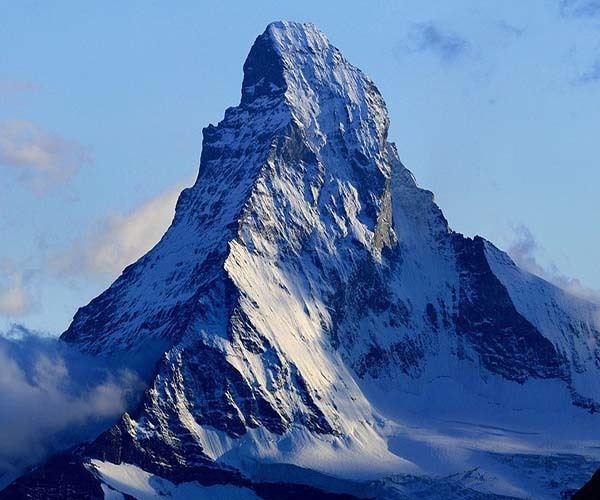
The Matterhorn, is Zermatts’ calling card and the king of mountains. Arguably the most photographed mountain in the world. The Matterhorn has a magic attraction, both for day-trippers who love the view and for Alpinists who love a challenge and dream of climbing the peak of the Matterhorn at least once in their lives. The first ascent was in 1865 and at that time the Matterhorn was the only remaining famous 4,000-metre peak to be conquered. The leader of the first ascent was Edward Whymper who did more than most to put Zermatt on the map.
Be warned, the Matterhorn is not to be taken lightly. A mountain guide is a must and the climb and return to earth is strictly for sure footed climbers with a good head for heights. The ascent demands stamina and a very good level of fitness. Thanks to its shape and its free-standing position, the Matterhorn is considered to be the epitome of a mountain. There is no better-known mountain in the world whose natural shape is so close to a pyramid. 100 million years ago, enormous forces brought Africa closer to Europe. 50 million years later, as the rock masses folded and deformed, the Matterhorn was born from the rock thrusting upwards.
From 1857 onwards, several unsuccessful attempts were made to climb the Matterhorn, mostly from the Italian side. When Edward Whymper arrived in Valtournenche in July 1865, this was already his sixth summer season in the area. During the previous five summers, Whymper had failed to climb the mountain regarded as the King of the Alps and considered to be unclimbable. Each unsuccessful climb boosted the mountain’s aura of invincibility, so that even experienced local mountain guides often turned down generous offers from foreign expedition leaders. But the Briton did not believe in mountain demons, and his project was based on calm reflection. He had studied the books of Horace Bénédict de Saussure and come to the conclusion that the mountain could be conquered from the Swiss north-east ridge rather than the Italian south-west. It was not Breuil that would be his starting point, but Zermatt!
On 14 July 1865, Whymper’s 7-man team completed the first ascent of the Matterhorn. The group climbed onto the shoulder over the Hörnligrat ridge and, further up, in the area of today’s fixed cables, diverted onto the north face. Edward Whymper was the first to reach the summit, followed by the mountain guide Michel Croz, the Reverend Charles Hudson, Lord Francis Douglas, Douglas Robert Hadow and the Zermatt mountain guides Peter Taugwalder senior and Peter Taugwalder junior. As the climbers were descending the four leading men in the rope group (Croz, Hadow, Hudson and Douglas) fell to their deaths on the north face. Three of the dead were recovered several days later on the Matterhorn Glacier, but the remains of Lord Francis Douglas were never found.
Every year, between 300 and 400 people attempt to climb the peak with a guide; of them, about 20 fail to reach the summit. Roughly 3,500 people tackle the Matterhorn without a guide each year; some 65 per cent turn back en route, usually because of lack of fitness or an insufficient head for heights. Poor weather also often plays a role: conditions change very quickly. Air Zermatt, founded in 1968, is frequently called to make rescues. On a day with ideal conditions, up to 300 mountaineers attempt the climb.
Weisshorn (4,505m)
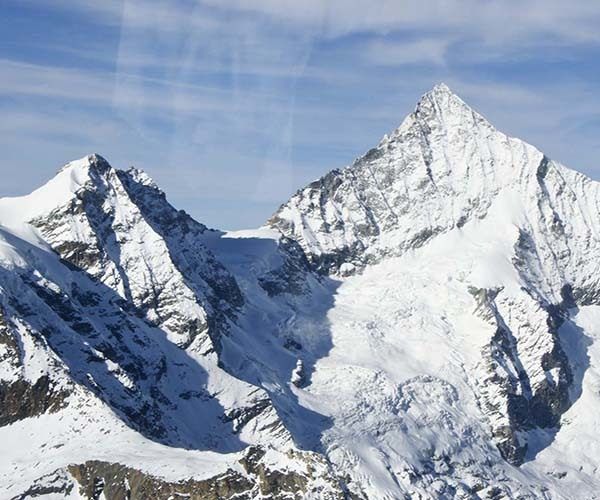
The Weisshorn is the secret star among the 4,000-metre peaks around Zermatt. It boasts a pleasing, symmetrical triangular shape; for mountaineers, it offers a thrilling challenge. The first ascent was in 1861 and was conquered by John Tyndall, Johann Joseph Benet, Ulrich Wenger. A mountain guide is necessary, it’s an arduous 2 dat trip and is considered a difficult climb.
The Weisshorn above Randa is considered one of the most important 4,000-metre peaks of the Alps. Although it cannot compete with the Matterhorn in terms of appearance, the Weisshorn is still relatively free-standing, and with its three ridges and faces forms a regular pyramid that is actually higher than the Matterhorn. In 2011, the people of Randa celebrated the 150th anniversary of the first ascent, along with numerous mountain guides from the whole region.
2011 was a special triple-anniversary year for Luzius Kuster, the warden of the Weisshorn hut. The Weisshorn was first climbed 150 years earlier; the Weisshorn hut had been open 111 years; and Luzius celebrated his 45th year as warden of the refuge. He first came to the cabin as a 20-year-old in 1966, staying for the summer “out of love for nature”, and remained – not least due to the generosity of his employer, who allowed him to be absent during the summer for several decades.
